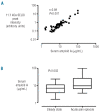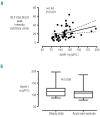Apolipoprotein A-I and serum amyloid A plasma levels are biomarkers of acute painful episodes in patients with sickle cell disease
- PMID: 20378559
- PMCID: PMC2930946
- DOI: 10.3324/haematol.2009.018044
Apolipoprotein A-I and serum amyloid A plasma levels are biomarkers of acute painful episodes in patients with sickle cell disease
Abstract
Background: Acute painful episodes are the clinical hallmark of sickle cell disease and have been linked to morbidity and mortality in the sickle cell population.
Design and methods: We undertook exploratory proteomic studies on paired plasma samples collected from a cohort of 26 adult sickle cell patients during steady state and on the first day of an acute painful episode. We screened for changes in abundance of specific protein peaks via surface-enhanced laser desorption/ionization time of flight mass spectrometry (SELDI-TOF MS), and confirmed the identify of candidate protein peaks by specific immunoassays.
Results: The levels of hemoglobin, hematocrit, total protein, and albumin were lower and the levels of lactate dehydrogenase and absolute reticulocytes higher during acute painful episodes than during the steady state. Surface-enhanced laser desorption/ionization time of flight mass spectrometry spectral analysis consistently showed a mass-to-charge peak at 11.7 kDa with elevated intensities during acute painful episodes, which correlated significantly with the serum amyloid A immunoassay. Serum amyloid A levels were significantly elevated during acute painful episodes, especially in four patients with marked end-organ complications of such episodes. A second, recurring peak, less abundant during acute painful episodes, was present at 28.1 kDa; this peak was correlated significantly with immunoassay measurements of apolipoprotein A1.
Conclusions: On the average, plasma serum amyloid A rises and apolipoprotein AI falls during acute painful episodes. The serum amyloid A/apolipoprotein AI ratio increased in 81% of the patients during acute painful episodes, potentially making it a useful objective marker of such episodes. We propose that these protein alterations, known to contribute to endothelial dysfunction in other settings, might do likewise acutely in acute painful episodes and present a new target for therapeutic intervention in sickle cell disease. (ClincalTrials.gov Identifier: NCT00081523).
Figures



Similar articles
-
Altered HDL particle in sickle cell disease: decreased cholesterol content is associated with hemolysis, whereas decreased Apolipoprotein A1 is linked to inflammation.Lipids Health Dis. 2019 Dec 20;18(1):225. doi: 10.1186/s12944-019-1174-5. Lipids Health Dis. 2019. PMID: 31861992 Free PMC article.
-
Proteomic identification of altered apolipoprotein patterns in pulmonary hypertension and vasculopathy of sickle cell disease.Blood. 2009 Jan 29;113(5):1122-8. doi: 10.1182/blood-2008-03-142604. Epub 2008 Nov 20. Blood. 2009. PMID: 19023114 Free PMC article. Clinical Trial.
-
Pre-treatment plasma proteomic markers associated with survival in oesophageal cancer.Br J Cancer. 2012 Feb 28;106(5):955-61. doi: 10.1038/bjc.2012.15. Epub 2012 Jan 31. Br J Cancer. 2012. PMID: 22294182 Free PMC article.
-
Serum amyloid A as a prognostic marker in melanoma identified by proteomic profiling.J Clin Oncol. 2009 May 1;27(13):2199-208. doi: 10.1200/JCO.2008.18.0554. Epub 2009 Mar 23. J Clin Oncol. 2009. PMID: 19307507
-
[Plasma analysis of rheumatoid arthritis by SELDI].Nihon Rinsho Meneki Gakkai Kaishi. 2007 Jun;30(3):145-50. doi: 10.2177/jsci.30.145. Nihon Rinsho Meneki Gakkai Kaishi. 2007. PMID: 17603254 Review. Japanese.
Cited by
-
Altered HDL particle in sickle cell disease: decreased cholesterol content is associated with hemolysis, whereas decreased Apolipoprotein A1 is linked to inflammation.Lipids Health Dis. 2019 Dec 20;18(1):225. doi: 10.1186/s12944-019-1174-5. Lipids Health Dis. 2019. PMID: 31861992 Free PMC article.
-
The proteome of sickle cell disease: insights from exploratory proteomic profiling.Expert Rev Proteomics. 2010 Dec;7(6):833-48. doi: 10.1586/epr.10.88. Expert Rev Proteomics. 2010. PMID: 21142886 Free PMC article. Review.
-
Proteomic discovery in sickle cell disease: Elevated neurogranin levels in children with sickle cell disease.Proteomics Clin Appl. 2021 Sep;15(5):e2100003. doi: 10.1002/prca.202100003. Epub 2021 May 24. Proteomics Clin Appl. 2021. PMID: 33915030 Free PMC article.
-
Reproducibility of SELDI Spectra Across Time and Laboratories.Cancer Inform. 2011 Mar 14;10:45-64. doi: 10.4137/CIN.S6438. Cancer Inform. 2011. PMID: 21552492 Free PMC article.
-
Lactate dehydrogenase and hemolysis in sickle cell disease.Blood. 2013 Aug 8;122(6):1091-2. doi: 10.1182/blood-2013-05-505016. Blood. 2013. PMID: 23929841 Free PMC article. No abstract available.
References
-
- Ballas SK. Sickle cell disease: clinical management. Baillieres Clin Haematol. 1998;11(1):185–214. - PubMed
-
- Embury SH, Hebbel RP, Mohandas N, Steinburg MH. Sickle Cell Disease: Basic Principles and Clinical Practice. New York, NY: Raven Press; 1994.
-
- Conran N, Franco-Penteado CF, Costa FF. Newer aspects of the pathophysiology of sickle cell disease vaso-occlusion. Hemoglobin. 2009;33(1):1–16. - PubMed
-
- Serjeant GR, Ceulaer CD, Lethbridge R, Morris J, Singhal A, Thomas PW. The painful crisis of homozygous sickle cell disease: clinical features. Br J Haematol. 1994;87(3):586–91. - PubMed
-
- Bailey S, Higgs DR, Morris J, Serjeant GR. Is the painful crisis of sickle-cell disease due to sickling? Lancet. 1991;337(8743):735. - PubMed
MeSH terms
Substances
Associated data
Grants and funding
LinkOut - more resources
Full Text Sources
Medical

